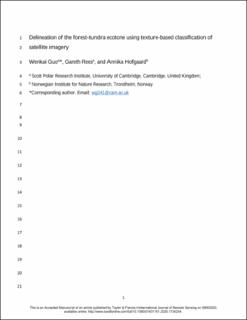Delineation of the forest-tundra ecotone using texture-based classification of satellite imagery
Peer reviewed, Journal article
Accepted version

Åpne
Permanent lenke
https://hdl.handle.net/11250/2659183Utgivelsesdato
2020Metadata
Vis full innførselSamlinger
- Publikasjoner fra CRIStin - NINA [2364]
- Scientific publications [1392]
Originalversjon
International Journal of Remote Sensing. 2020, 41 (16), 6384-6408. 10.1080/01431161.2020.1734254Sammendrag
The transition zone between the boreal forest and Arctic tundra, the forest-tundra ecotone (FTE), is an area of high ecological and climatological significance. Despite its importance, a globally consistent high spatial resolution mapping is lacking. Accurate mapping of the FTE requires the use of satellite remote sensing data. Here we use the Landsat Vegetation Continuous Fields (VCF) product and Reference point data to derive the location and characteristics of the FTE. An image texture-based supervised classification scheme is developed based on a study area in Central Eurasia to statistically exploit the spatial patterns of the transition zone. Texture statistics for the VCF image are derived from the grey-level co-occurrence matrix (GLCM) based on which the study area is classified into forest, tundra, and FTEs. Adaptive parameterization is implemented to achieve optimal classification performance in the study area. This method is further applied to six additional study areas around the circumarctic region to test its adaptability. In all study areas, this method achieves better FTE delineation results than previously reported methods, showing better classification accuracies (average of 0.826) and more realistic and complete representation of the FTE as shown by visual examination. This shows the universal applicability of the method and it is potential to be used to achieve more detailed and accurate circumarctic mapping of the FTE, which could serve as the basis of time series analysis of FTE positions, eventually contributing to a better understanding of the inter-relations between climate change and shifts in sub-arctic vegetation.